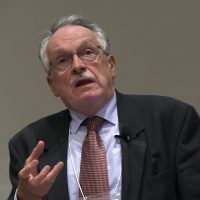‘Fascism’ today is an invective and a tool of propaganda rather than a concept helping us to understand matters. Yet the lockdowns in the name of a ‘pandemic’, are often still in place and bound to be resurrected where they have been lifted. Extreme police violence against protesters, as well as the aggressive censorship of Julian Assange, Chelsea Manning, Edward Snowden, and many others, raise the question of how to label the changes in the state structures of formerly parliamentary ruled countries.
The Western liberal heartland is showing all the signs of creeping authoritarianism.
In other countries, such as China, authoritarian structures were already in place and are merely being tightened in response to a restive population. The recent lockdown of Shanghai and its 26 million inhabitants on account of a few ‘cases’ of Covid infection is a case in point. But Italy too has turned into a theatre of the absurd and the city of Bologna is going to experiment with a Chinese-style social credit system. This is, no doubt, facilitated by the fact that its prime minister, former Goldman Sachs banker and ex-president of the European Central Bank, never had to pass the rest of an election. Yet can we call that fascism?
The rise of the original fascism was analysed by two contemporaries, Antonio Gramsci in Italy and the Social Democrat, Franz Neumann, in Germany. Gramsci’s prison notes, smuggled out of the cell where he was held on Mussolini’s orders, were published after the war and contain some of the major advances of Marxist theory after the Russian Revolution, including on the rise of fascism. There was an international campaign for Gramsci’s release but when the fascist state decided to let him go, he was so ill that he soon perished. Is this perhaps a scenario we may witness again in the case of Assange?
Franz Neumann left Germany for the United States following the appointment of Adolf Hitler to the post of Chancellor. Neumann made his name with his study of the Nazi state, Behemoth (after the Biblical monster). Before that, Neumann had written a number of articles in German on the process of fascisation, the run-up to the actual imposition of fascist dictatorship—which transpired via the Reichstag fire, the outlawing of the left-wing parties, and the enabling law.
That parliament in the process of fascisation continued to meet as if nothing were happening, which in Neumann’s analysis fitted the fascisation scenario, as it did in Gramsci’s. For as a political form, fascism itself was also an adjustment to the right to vote. Under that regime, consolidating the power of the ruling class in a crisis no longer exclusively relied on a violent coup d’état, such as Hitler’s failed one in 1923, or in our own age, Pinochet’s in Chile. Instead, militant conservatism relied on being made popular and gaining a mass following. Nationalism was the obvious theme on which people could be mobilised: in Italy, which had joined the victors towards the end of the First World War, a furious nationalism arose when it turned out the expected spoils eluded it; in Germany, extreme nationalism was also fed by the disbelief that its military machine could ever have been defeated. The culprits, it was believed, were easily identified: the left and the Jews.
In the phase of fascisation, then, parliamentary rules remained largely respected, because, to be eligible for government, electoral success was necessary. Once government had been secured, the façade of democracy could be dropped and overt violence and war could follow. There had never been any doubt that this was also the programme of the fascists, yet the building of what Neumann calls an anti-state next to the prevailing state of law could proceed to the point of the imposition of a state of emergency, a powerful and readily exploitable propaganda event, that facilitates the transition.
Today across the West, we observe a comparable willingness to allow the limits of the parliamentary regime and legality being explored. Everywhere the violence against demonstrators, censorship in combination with a propagandistic role for the established media, and reckless provocations like the ones leading to Russia’s intervention in Ukraine, reveal the reality of contemporary fascisation. History never repeats itself, but neither can we rest assured that if it looks like it nevertheless, the repeat performance will only be a farce.
Once again, the underlying, strategic aim of the ruling class is to break through to a new stage of capitalist social organisation—in 1930s Europe, to emulate the breakthrough of Fordist mass production of consumer durables achieved in the United States; today the establishment of a digital world economy centrally controlled by a quasi-state at the global level (with its government departments in the form of NATO, the IMF, WHO etc.). Klaus Schwab’s long-held ideas in this respect in the current crisis have been re-branded as The Great Reset.
This time, however (and a source of widespread confusion), the threat to democracy is no longer coming from a militant extreme right, but from the radical centre. Yet as in the 1930s, the anti-state is maturing behind the façade of politics as usual. The growing role of national security agencies, mass surveillance, propaganda, the suspension of basic rights, are in progress and yet few parliamentarians or mainstream journalists appear to notice that effective control is being suspended.
Gramsci too recognised a phase of fascisation, which he characterised as ‘corruption and fraud’ (corruption in the sense of a rotting process, not just financial). These too are in evidence today, from the systematic lying by governments to election fraud. The Covid lockdowns in the liberal West, with curfews and travel restrictions and mass inoculation campaigns of dangerous experimental medications pushed on the false promise of their being lifted, is a contemporary form of corruption and fraud. As is their actual suspension, apparently a manoeuvre to release growing social tension before a renewed assault on the population.
In many respects, we face a completely different political landscape compared to the thirties of the last century. The ‘left’ of Neumann and Gramsci no longer represents the working population; the label has become an invective against the radical centre. Yet one of the new political forms developed in those days to stem the fascist tide is still topical: the Popular Front. In 1935, when it was too late already in Italy and Germany, the Communist International abandoned its disastrous far left policy of the preceding period for a common defence of democracy. Popular Front governments were formed in Spain and France on this basis, and communist parties even remained outside them in order not to frighten the bourgeoisie. Changes in property relations were off the agenda too. It did not help. Hitler and Mussolini were allowed by the other powers to actively support the rebellion by General Franco in Spain, and in 1940 large parts of the French ruling class and state preferred to surrender to Nazi Germany rather than risk a return of a Popular Front government.
Even so, the idea of a Popular Front may become topical again, under this or any other label. There is a broad movement of resistance against the creeping suspension of democracy, but in many countries its political representation is too narrow, confined to originally right wing, even far right parties now that the historic left has merged into the radical centre. Many politically homeless people are therefore not inclined to join these parties (Le Pen’s in France, AfD in Germany, Salvini in Italy…). In turn, their social basis is often vehemently opposed to traditional left policies of redistribution and nationalisation. Internationalism versus nationalism too is a divisive issue, although Gramsci already warned that raising the Red Flag against the Italian Tricolore was a mistake, as patriotism should not be dismissed and left to nationalist agitation. However, the issue today is the defence of democracy against the imposition by the radical centre of authoritarian control structures ultimately subservient to a globalised quasi-state. In that fight, the originally far right parties are already expanding their ranks and become ‘moderate’ to accommodate the new recruits, a process transpiring unplanned and in often contradictory ways. To break out of the political quarantine inherited from their original xenophobic antecedents, new Popular Fronts for the defence of democracy and the state of law, leaving property and economic issues temporarily suspended, might be a way of breaking the deadlock. Political struggle might then be resumed later, but on the basis of a solidified democratic consensus.
Kees van der Pijl is the author of States of Emergency. Keeping the Global Population in Check (Atlanta, GA: Clarity Press).
(Featured Image: “Coronavirus children” by https://www.vperemen.com is licensed under CC BY 2.0.)





